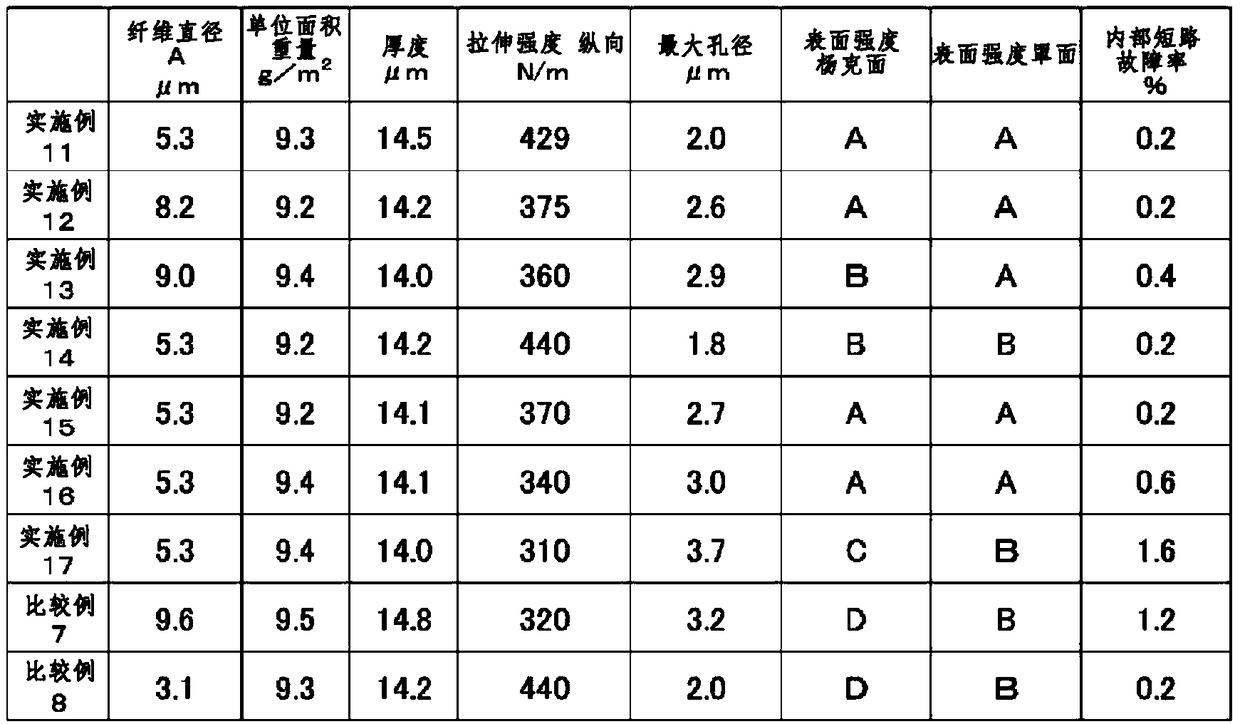Separator for electrochemical elements, and electrochemical element using same
一种电化学元件、隔离物的技术,应用在电气元件、电解电容器、电池组零部件等方向,能够解决阻碍密封等问题,达到故障少、内部短路故障率小、表面平滑性高的效果
- Summary
- Abstract
- Description
- Claims
- Application Information
AI Technical Summary
Problems solved by technology
Method used
Image
Examples
Embodiment 1
[0082] Mix 15 parts of rayon fibers with a fineness of 0.8 dtex and a fiber length of 3 mm and 85 parts of solvent-spun cellulose fibers with a beating degree of 90 ml by a modified method, and dissociate them in the water of a pulper, and use a stirrer to After stirring, a uniform raw material slurry (0.3% concentration) was prepared. The beaten solvent-spun cellulose fibers were obtained by finely refining solvent-spun cellulose fibers having a fiber diameter R of 10 μm and a fiber length of 4 mm. A wet-laid fiber web was obtained from the raw material slurry using an inclined short-wire paper machine. The wet fiber web was dried using a Yankee dryer (temperature 120° C.) and a hot air hood dryer (temperature 120° C.) installed on the upper surface of the Yankee dryer to obtain a dried fiber web. Thereafter, the dried web was subjected to a calender treatment using metal rolls and elastic rolls to obtain a basis weight of 17.3 g / m 2 , A spacer with a thickness of 30.4 μm. ...
Embodiment 2
[0084] The rayon fibers in Example 1 were set to 25 parts, and the solvent-spun cellulose fibers formed by beating were set to 75 parts, except that, the same method was used to obtain a weight per unit area of 17.4 g / m 2 , A spacer with a thickness of 30.2 μm.
Embodiment 3
[0086] The rayon fiber in Example 1 was set as 10 parts, and the solvent spinning cellulose fiber formed by beating was set as 90 parts, except that, the same method was used to obtain a weight per unit area of 17.2 g / m 2 , A spacer with a thickness of 30.1 μm.
PUM
| Property | Measurement | Unit |
|---|---|---|
| diameter | aaaaa | aaaaa |
| diameter | aaaaa | aaaaa |
| diameter | aaaaa | aaaaa |
Abstract
Description
Claims
Application Information
 Login to View More
Login to View More - R&D
- Intellectual Property
- Life Sciences
- Materials
- Tech Scout
- Unparalleled Data Quality
- Higher Quality Content
- 60% Fewer Hallucinations
Browse by: Latest US Patents, China's latest patents, Technical Efficacy Thesaurus, Application Domain, Technology Topic, Popular Technical Reports.
© 2025 PatSnap. All rights reserved.Legal|Privacy policy|Modern Slavery Act Transparency Statement|Sitemap|About US| Contact US: help@patsnap.com



